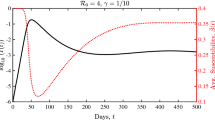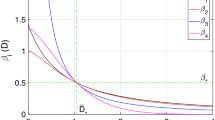Abstract
Let the individuals of a population be divided into two groups with different personal habits. The core group is associated with health risk behaviors; the non-core group avoids unhealthy activities. Assume that the infected individuals of the core group can spread a contagious disease to the whole population. Also, assume that cure does not confer immunity. Here, an epidemiological model written as a set of ordinary differential equations is proposed to investigate the infection propagation in this population. In the model, migrations between these two groups are allowed; however, the transitions from the non-core group into the core group prevail. These migrations can be either spontaneous or stimulated by social pressure. It is analytically shown that, in the scenario of spontaneous migration, the disease is either naturally eradicated or chronically persists at a constant level. In the scenario of stimulated migration, in addition to eradication and constant persistence, self-sustained oscillations in the number of sick individuals can also be found. These analytical results are illustrated by numerical simulations and discussed from a public health perspective.
Similar content being viewed by others
References
Almocera LS, Zhujun J, Sy PW (2001) Hopf bifurcation and analysis of equilibrium for a third-order differential equation in a model of competition. Acta Math Appl Sin 17:68–80
Anderson RM, May RM (1992) Infectious diseases of humans: dynamics and control. Oxford University Press, Oxford
Barbaric J, Kuchukhidze G, Seguy N, Vovc E, Babovic MJT, Wi TE, Low-Beer D, Bozicevic I (2022) Surveillance and epidemiology of syphilis, gonorrhoea and chlamydia in the non-European Union countries of the World Health Organization European Region, 2015 to 2020. Eurosurveillance 27:2100197
Bukh J (2016) The history of hepatitis C virus (HCV): basic research reveals unique features in phylogeny, evolution and the viral life cycle with new perspectives for epidemic control. J Hepatol 65:S2–S21
Camacho ET (2013) The development and interaction of terrorist and fanatic groups. Commun Nonlinear Sci Numer Simul 18:3086–3097
Chan CH, McCabe CJ, Fisman DN (2012) Core groups, antimicrobial resistance and rebound in gonorrhoea in North America. Sex Transm Infect 88:200–204
Chaves LL, Monteiro LHA (2017) Oscillations in an epidemiological model based on asynchronous probabilistic cellular automaton. Ecol Complex 31:57–63
Chen MI, Ghani AC, Edmunds WJ (2009) A metapopulation modelling framework for gonorrhoea and other sexually transmitted infections in heterosexual populations. J R Soc Interface 6:775–791
Gandon S, Day T, Metcalf CJE, Grenfell BT (2016) Forecasting epidemiological and evolutionary dynamics of infectious diseases. Trends Ecol Evol 31:776–788
Gesink DC, Sullivan AB, Miller WC, Bernstein KT (2011) Sexually transmitted disease core theory: roles of person, place, and time. Am J Epidemiol 174:81–89
Greenhalgh D, Griffiths M (2009) Dynamic phenomena arising from an extended Core Group model. Math Biosci 221:136–149
Guckenheimer J, Holmes P (2002) Nonlinear oscillations, dynamical systems, and bifurcations of vector fields. Springer, New York
Hadeler KP, Castillo-Chavez C (1995) A core group model for disease transmission. Math Biosci 128:41–55
Harari GS, Monteiro LHA (2022) An epidemic model with pro and anti-vaccine groups. Acta Biotheor 70:20
Hethcote HW (2000) The mathematics of infectious diseases. SIAM Rev 42:599–653
Hollingsworth TD (2009) Controlling infectious disease outbreaks: lessons from mathematical modelling. J Public Health Policy 30:328–341
Mushanyu J, Nyabadza F, Muchatibaya G, Stewart AGR (2017) On the role of imitation on adolescence methamphetamine abuse dynamics. Acta Biotheor 65:37–61
Nakashima AK, Rolfs RT, Flock ML, Kilmarx P, Greenspan JR (1996) Epidemiology sf syphilis in the United States, 1941–1993. Sex Transm Dis 23:16–23
Nyabadza F, Ogbogbo CP, Mushanyu J (2017) Modelling the role of correctional services on gangs: insights through a mathematical model. R Soc Open Sci 4:170511
Ogata K (2001) Modern control engineering. Prentice-Hall, New York
Pastor-Satorras R, Castellano C, Van Mieghem P, Vespignani A (2015) Epidemic processes in complex networks. Rev Mod Phys 87:925–979
Pinto CN, Dorn LD, Chinchilli VM, Du P, Chi GQ (2017) Rural counties chlamydia and gonorrhea rates in Pennsylvania among adolescents and young adults. Ann Epidemiol 27:606–610
Piqueira JRC, Castano MC, Monteiro LHA (2004) Modeling the spreading of HIV in homosexual populations with heterogeneous preventive attitude. J Biol Syst 12:439–456
Rowley J, Vander Hoorn S, Korenromp E, Low N, Unemo M, Abu-Raddad LJ, Chico RM, Smolak A, Newman L, Gottlieb S, Thwin SS, Broutet N, Taylor MM (2019) Chlamydia, gonorrhoea, trichomoniasis and syphilis: global prevalence and incidence estimates, 2016. Bull World Health Organ 97:548-562P
Salari N, Kazeminia M, Hemati N, Ammari-Allahyari M, Mohammadi M, Shohaimi S (2022) Global prevalence of hepatitis C in general population: a systematic review and meta-analysis. Travel Med Infect Dis 46:102255
Shulgin B, Stone L, Agur Z (1998) Pulse vaccination strategy in the SIR epidemic model. Bull Math Biol 60:1123–1148
Stone L, Olinky R, Huppert A (2007) Seasonal dynamics of recurrent epidemics. Nature 446:533–536
Thomas JC, Tucker MJ (1996) The development and use of the concept of a sexually transmitted disease core. J Infect Dis 174:S134–S143
Turnes PP Jr, Monteiro LHA (2014) An epidemic model to evaluate the homogeneous mixing assumption. Commun Nonlinear Sci Numer Simul 19:4042–4047
World Health Organization (WHO) (2021) World health statistics 2021. WHO, Geneva
Worldometer (2022) Countries in the world by population. https://www.worldometers.info/world-population/#region. Accessed 04 Dec 2022
Worldometer (2023) Current world population. https://www.worldometers.info/world-population/#pastfuture. Accessed 18 Mar 2023
Yorke JA, Hethcote HW, Nold A (1978) Dynamics and control of the transmission of gonorrhea. Sex Transm Dis 5:51–56
Zhang QP, Gao JX, Wu JT, Cao ZD, Zeng DDJ (2022) Data science approaches to confronting the COVID-19 pandemic: a narrative review. Philos Trans R Soc A-Math Phys Eng Sci 380:20210127
Acknowledgements
APBJ thanks to Coordenação de Aperfeiçoamento de Pessoal de Nível Superior (CAPES) for the scholarship. LHAM is partially supported by Conselho Nacional de Desenvolvimento Científico e Tecnológico (CNPq) under the grant #302946/2022-5.
Author information
Authors and Affiliations
Corresponding author
Ethics declarations
Conflicts of Interest
The authors declare that there are no conflicts of interest regarding the publication of this paper.
Additional information
Publisher's Note
Springer Nature remains neutral with regard to jurisdictional claims in published maps and institutional affiliations.
Appendix
Appendix
The type of Hopf bifurcation (supercritical, subcritical, or degenerate) can be determined by deriving the normal form of the underlying dynamical system, as summarized below (Guckenheimer and Holmes 2002).
Consider Eqs. (5)–(7) with \(q=1\). First, shift the endemic equilibrium point to the origin of a new set of variables, by defining \(X_1=S-S_{ende}^{1*}, X_2=S_c-S_{c,ende}^{1*}\), and \(X_3=I_c-I_{c,ende}^{1*}\). In these new coordinates, Eqs. (5)-(7) are rewritten as \(d\textbf{X}/{dt}=\textbf{f}(\textbf{X})\), with \(\textbf{X}=(X_1,X_2,X_3)\) and \(\textbf{f}=(f_1(\textbf{X}),f_2(\textbf{X}),f_3(\textbf{X}))\). Assume that the origin of this system experiences a Hopf bifurcation for a particular combination of parameter values. Thus, at this bifurcation point, the eigenvalues of the Jacobian matrix \(\textbf{J}\) are \(\lambda _{1,2}=\pm i \omega\) and \(\lambda _3<0\). Let \(\mathbf{v_1}=\textbf{a}+i\textbf{b}\) be an eigenvector associated with \(\lambda _1=i\omega\) and \(\mathbf{v_3}=\textbf{c}\) an eigenvector associated with \(\lambda _3\). Let the columns of a matrix \(\textbf{P}\) be formed by \(\textbf{a}, -\textbf{b}\), and \(\textbf{c}\). Then, rewrite \(d\textbf{X}/{dt}=\textbf{f}(\textbf{X})\) in terms of \(\textbf{Y}=(Y_1,Y_2,Y_3)\), so that \(\textbf{Y}=\textbf{P}^{-1} \textbf{X}\). This new change of variables leads to:
in which \(\psi , \varphi\), and \(\zeta\) are nonlinear functions of \(\textbf{Y}\). Notice that the linear part of Eq. (A.1) is in the Jordan normal form (Guckenheimer and Holmes 2002). The matrix of this linear part is obtained from \(\textbf{P}^{-1}{} \textbf{J}{} \textbf{P}\). The flow restricted to the center manifold near the origin can be described by \(dY_1/dt\) and \(dY_2/dt\), by taking (Guckenheimer and Holmes 2002):
Since \(dY_3/dt = \lambda _3 Y_3 + \zeta\), then:
or:
The constants \(k_1, k_2\), and \(k_3\) in Eq. (A.2) are calculated by imposing that the coefficients of \((Y_1)^2, Y_1Y_2\), and \((Y_2)^2\) in Eq. (A.4) must be null (and neglecting the terms of higher orders). The first Lyapunov coefficient \(L_1\), obtained from the functions \(\psi (Y_1,Y_2,H(Y_1,Y_2))\) and \(\varphi (Y_1,Y_2,H(Y_1,Y_2))\), is defined as Guckenheimer and Holmes (2002):
in which \(\psi _{Y_1 Y_1 Y_1} = \partial ^3 \psi / \partial Y_1^3, \psi _{Y_1 Y_2 Y_2} = \partial ^3 \psi / \partial Y_1 \partial Y_2^2\) and so on. The coefficient \(L_1\) must be computed at the bifurcation point. If \(L_1<0\), the Hopf bifurcation is supercritical and the emerging limit cycle is asymptotically stable; if \(L_1>0\), the Hopf bifurcation is subcritical and the emerging limit cycle is unstable (Guckenheimer and Holmes 2002).
For the proposed model, Eqs. (5)–(7) can be rewritten as explained above from the following matrix \(\textbf{P}\):
in which \(A=-\delta _1^1=\lambda _3, D=\epsilon S_c^{1*}, E=-\alpha S_c^{1*}, F=\alpha I_c^{1*}\), and \(\omega = \sqrt{\delta _2^1}\). The matrix inverse \(\textbf{P}^{-1}\) is given by:
Let \(p_{ij}\) be the coefficient (i, j) of \(\textbf{P}\) and \(\eta _{ij}\) the coefficient (i, j) of \(\textbf{P}^{-1}\). For the proposed model:
As a consequence:
The coefficient \(L_1\) is computed from Eqs. (A.11)–(A.20).
Time evolutions of S(t) (blue line), \(S_c(t)\) (green line), I(t) (red line), and \(I_c(t)\) (magenta line) for \(q=0, b=0.05, c=0.02, \beta =0.04, \gamma =0.03, \epsilon =0.025, m=0.02\), and \(N=1\) from the initial condition \((S(0),S_c(0),I(0),I_c(0))=(0.97,0.01,0.01,0.01)\). In (a), \(a=1/20\) and \(\alpha =1/10\). In this case, \((S(t),S_c(t),I(t),I_c(t)) \rightarrow (S^{0*}_{free}, S_{c,free}^{0*}, I_{free}^{0*}, I_{c,free}^{0*}) = (0.444, 0.556, 0, 0)\). In (b), \(a=2/5\) and \(\alpha =4/5\). In this case, \((S(t),S_c(t),I(t),I_c(t)) \rightarrow (S^{0*}_{ende}, S_{c,ende}^{0*}, I_{ende}^{0*}, I_{c,ende}^{0*}) = (0.442, 0.088, 0.337, 0.133)\)
Time evolutions of S(t) (blue line), \(S_c(t)\) (green line), I(t) (red line), and \(I_c(t)\) (magenta line) for \(q=1, b=0.05, c=0.02, \beta =0.04, \gamma =0.03, \epsilon =0.025\), and \(N=1\) from the initial condition \((S(0),S_c(0),I(0),I_c(0))=(0.97,0.01,0.01,0.01)\). In (a), \(a=1/6, \alpha =1/3\), and \(m=0.03\). In this case, \((S(t),S_c(t),I(t),I_c(t)) \rightarrow (S^{1*}_{clean}, S_{c,clean}^{1*}, I_{clean}^{1*}, I_{c,clean}^{1*}) = (1, 0, 0, 0)\). In (b), \(a=1/6, \alpha =1/3\), and \(m=0.02\). In this case, \((S(t),S_c(t),I(t),I_c(t)) \rightarrow (S^{1*}_{free}, S_{c,free}^{1*}, I_{free}^{1*}, I_{c,free}^{1*}) = (0.8, 0.2, 0, 0)\). In (c), \(a=2/5, \alpha =4/5\), and \(m=0.02\). In this case, \((S(t),S_c(t),I(t),I_c(t)) \rightarrow (S^{1*}_{ende}, S_{c,ende}^{1*}, I_{ende}^{1*}, I_{c,ende}^{1*}) = (0.894, 0.088, 0.015, 0.003)\). In (d), \(a=2, \alpha =4\), and \(m=0.02\). In this case, \((S(t),S_c(t),I(t),I_c(t))\) converge to a self-sustained oscillation
Rights and permissions
Springer Nature or its licensor (e.g. a society or other partner) holds exclusive rights to this article under a publishing agreement with the author(s) or other rightsholder(s); author self-archiving of the accepted manuscript version of this article is solely governed by the terms of such publishing agreement and applicable law.
About this article
Cite this article
Baccili, A.P., Monteiro, L.H.A. Social Pressure from a Core Group can Cause Self-Sustained Oscillations in an Epidemic Model. Acta Biotheor 71, 18 (2023). https://doi.org/10.1007/s10441-023-09469-3
Received:
Accepted:
Published:
DOI: https://doi.org/10.1007/s10441-023-09469-3






